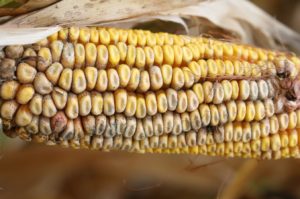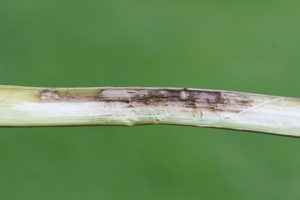by Thomas Isakeit, Professor and Extension Plant Pathologist, Department of Plant Pathology and Microbiology, Texas A&M University, College Station; Jourdan Bell, Assistant Professor and Agronomist, Texas A&M AgriLife Research and Extension Center, Amarillo; Ted McCollum III, Professor and Extension Beef Cattle Specialist, Texas A&M AgriLife Research and Extension Center, Amarillo
Fumonisins are toxins produced in corn kernels by two species of fungi (Fusarium verticillioides and F. proliferatum). These toxins are carcinogens and can cause illness in livestock, particularly in horses. The levels of fumonisin allowed in food and feed are regulated. For example, horse feed is not to exceed 5 parts per million (ppm), while breeding animals are allowed up to 30 ppm and ruminants are allowed up to 60 ppm.
The Fusarium fungus causes a rot of kernels (Figure 1). Such kernels have very high levels of fumonisin, often exceeding 500 ppm. Intact kernels adjacent to rotted kernels can be colonized by the fungus and can also have high levels of fumonisin. Most kernels on an ear of corn with ear rot, although colonized by the fungus, have no or very low levels of fumonisin. There are several environmental factors that affect fumonisin concentration during the growing season. However, the production of fumonisin by the fungus requires a specific nutrient from the plant, amylopectin, which is a component of starch. Although the fungus can grow on all plant parts and it is known to cause a stalk rot (Figure 2), the toxin requirement for amylopectin limits production of the toxin to maturing kernels.
This amylopectin requirement explains why fumonisin contamination is not a problem in grazing harvested corn fields, where the plant residues are largely stalk and leaf tissue that do not support toxin production. In the case of silage, ears are usually harvested at an immature stage when toxin accumulation is minimal, and they are diluted in the silage biomass. Additionally, the fungus does not grow under the anaerobic conditions of silage.
Based on this information, grazing corn fields where fumonisin has been detected in corn should not be a problem. Although stalks and leaves do not contain fumonisin, the cobs remaining in the field might have low levels of fumonisin, particularly if Fusarium-colonized seeds are still attached. Smaller, broken kernels that are not collected in the combine and remain in the field will likely have higher levels of fumonisin.
Should fields be burned to control future fumonisin problems?
This has never been explicitly tested, but is not likely to make a difference. Here are the reasons: These species of Fusarium are everywhere. They do persist on crop residue, but they grow readily on many plant species, without causing disease symptoms. A comparative study in Australia showed that these Fusarium species were retained in corn fields where the residue was incorporated into soil, but greatly diminished when that residue was burned. However, this study did not evaluate the effect of these treatments on stalk rot or fumonisin of subsequent corn crops. A field study in Nigeria showed less Fusarium stalk rot of corn in plots grown with minimal tillage, as compared with plots grown following burning of residue. Tillage is often considered an option for managing fungal diseases by burying the residue; however, the fungi are soilborne so tillage does not always reduce the inoculum. In a tillage study in South African, tillage practices had not effect on minimizing Fusarium ear rots of corn.
Although fluctuations of populations of Fusarium species occur from year to year, one must consider that there is always a sufficient, minimal population of Fusarium present to infect corn kernels, but the severity of fumonisin contamination will be determined by the environmental conditions occurring during the current growing season. These stresses include the lack of moisture during and after flowering, followed by wet weather later in the season. Management of future fumonisin contamination should focus on crop management during the current season, including selection of a hybrid adapted to stress, the use of a good insect control trait, and management of the field to reduce moisture stress. Occurrence of contamination in a field in one year does not mean that it will necessarily occur in future years.
More fumonisin information can be found at:
https://amarillo.tamu.edu/files/2016/10/Understanding-Fumonisin-Contamination-of-Corn.pdf
http://amarillo.tamu.edu/files/2010/11/10_PPB_BMP_Mycotoxin_CORN.pdf
More general information about ear rots of corn:
http://www.cornmycotoxins.com/home/

Thomas Isakeit, Ph.D.
Professor and Extension Plant Pathologist
College Station, TX
t-isakeit@exchange.tamu.edu

